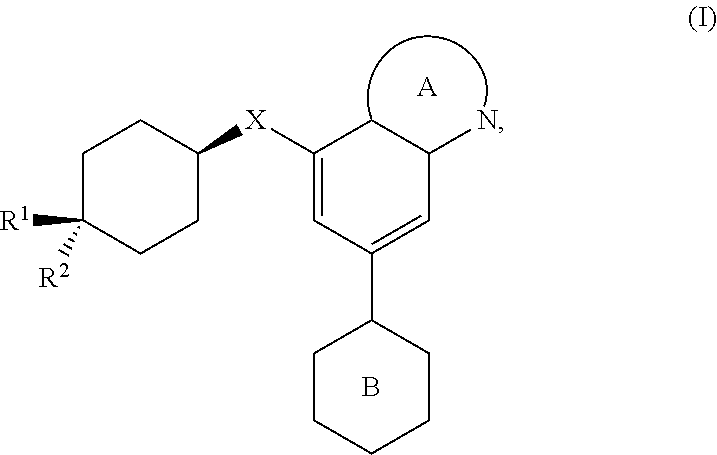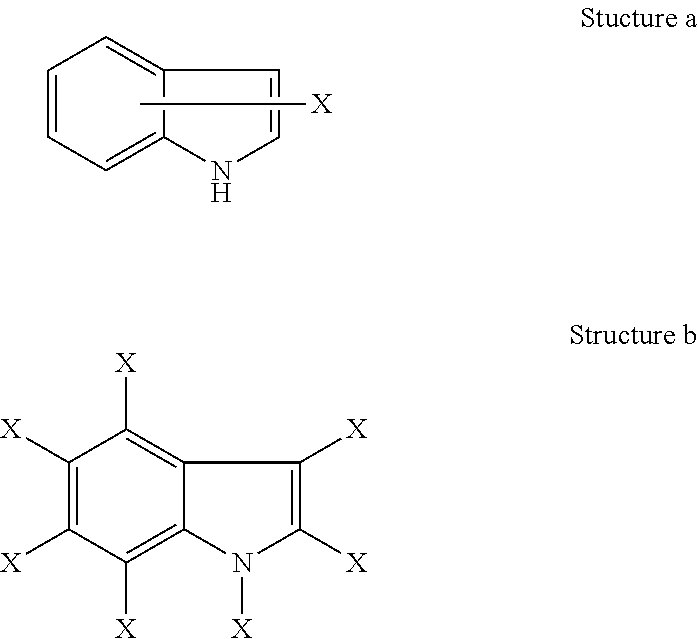Dna-pk inhibitors
- Summary
- Abstract
- Description
- Claims
- Application Information
AI Technical Summary
Benefits of technology
Problems solved by technology
Method used
Image
Examples
example 1
General Preparation of the Compounds of Formula G
[0118]
[0119]Compounds of formula I, wherein X1 is NH (i.e., compounds of formula I-A), can be prepared as outlined below in Scheme 1. Accordingly, as shown in step 1-i of Scheme 1, heteroaryl compounds of formula A can be reacted with morpholine or a morpholine analog by heating the mixture in a polar, non-protic solvent to produce compounds of formula B. Utilizing a palladium-catalyzed, phosphine ligand-assisted Buchwald / Hartwig-type coupling, as shown in step 1-ii of Scheme 1, a compound of formula B can be reacted with aminocyclohexanes of formula C to produce compounds of formula D, wherein R1 and R2 are as described elsewhere herein. In one example, when monoprotected meso cyclohexane-1,4-diamines of formula E are prepared, removal of the protecting group forms compounds of formula F, as shown in step 1-iii of Scheme 1. The resulting free amine can then be reacted with various moieties having groups reactive towards amines (e.g.,...
example 2
General Preparation of the Compounds of Formula M, N, R, and S
[0120]
[0121]Compounds of formula I, wherein Xi is O can be prepared as outlined below in Schemes 2a and 2b. Accordingly, as shown in step 2-i of Scheme 2a, the hydroxyl group of heteroaryl compounds of formula H can be protected to produce compounds of formula J, which can then be reacted with morpholine or a morpholine analog by heating the mixture in a polar, non-protic solvent to produce compounds of formula K after removal of the protecting group, as shown in steps 2-ii and 2-iii of Scheme 2a. Subsequently, as shown in step 2-iv of Scheme 2a, a compound of formula K can be reacted with a compound of formula L under conditions sufficient to affect the SN2 displacement of its leaving group (e.g., where L is a leaving group such as chloro, bromo, iodo, toluenesulfonate, methanesulfonate, or trifluoromethanesulfonate) to produce a compound of formula M or formula M, depending on whether R1 or R2 is hydrogen. In those inst...
example 3
Preparation of ethyl (4-((7-morpholinoquinoxalin-5-yl)amino)cyclohexyl)carbamate (Compound 6) and N1-(7-morpholinoquinoxalin-5-yl)-N4-(pyrimidin-2-yl)cyclohexane-1,4-diamine (Compound 18)
[0124]
[0125]As shown in step 3-i of Scheme 3, to a solution of 3-bromo-5-fluoro-benzene-1,2-diamine (compound 1001, 1.11 g, 5.41 mmol) in methanol (11 mL) was added oxaldehyde (1.57 mL of 40% w / v, 10.8 mmol). The reaction mixture was stirred at room temperature under nitrogen. After 2 hours a yellow solid precipitated. The reaction mixture was diluted with water (20 mL), stirred an additional 5 minutes, filtered, and the collected solid dried under high vacuum to produce 5-bromo-7-fluoroquinoxaline (compound 1002, 868 mg, 70.6% yield): 1H-NMR (300 MHz, DMSO-d6) δ 9.06 (s, 2H), 8.36 (dd, J=8.5, 2.7 Hz, 1H), 8.00 (dd, J=9.2, 2.7 Hz, 1H); ESMS (M+H+)=227.14.
[0126]As shown in step 3-ii of Scheme 3, to a solution of 5-bromo-7-fluoroquinoxaline (4.5 g, 19.8 mmol) in NMP (67.5 mL) was added morpholine (3.1...
PUM
| Property | Measurement | Unit |
|---|---|---|
| Therapeutic | aaaaa | aaaaa |
Abstract
Description
Claims
Application Information
 Login to View More
Login to View More - R&D
- Intellectual Property
- Life Sciences
- Materials
- Tech Scout
- Unparalleled Data Quality
- Higher Quality Content
- 60% Fewer Hallucinations
Browse by: Latest US Patents, China's latest patents, Technical Efficacy Thesaurus, Application Domain, Technology Topic, Popular Technical Reports.
© 2025 PatSnap. All rights reserved.Legal|Privacy policy|Modern Slavery Act Transparency Statement|Sitemap|About US| Contact US: help@patsnap.com



